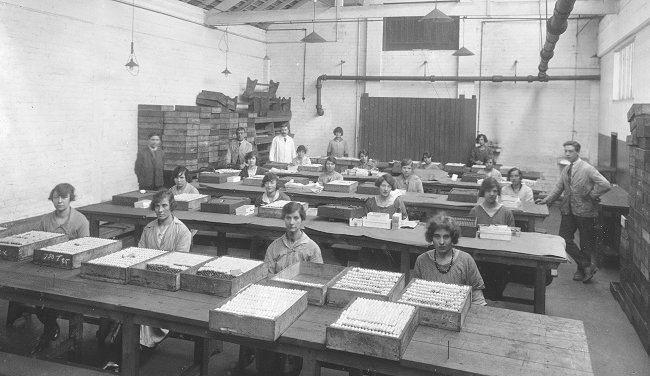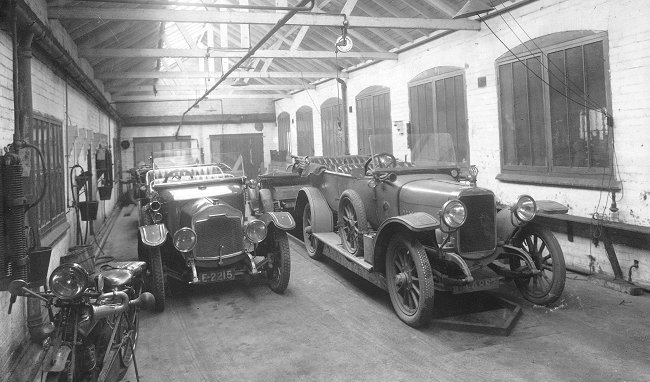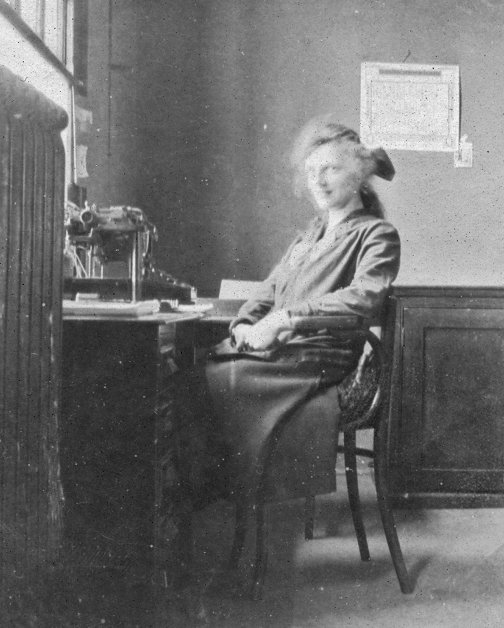|
The Efandem Company was formed in
1903 in premises at 71 Temple Row, Birmingham, to
manufacture batteries. The name is derived from the
initials of the two directors, F. and M.
In 1911 it
became a limited company, and moved to a new and much larger
factory in Park Lane, Wolverhampton. The company acquired a
14 year lease, at an annual rent of £100 from the landlord,
Sir Arthur Paget, Bart., owner of the Fallings Park Estate.
Efandem
produced a wide range of electrical goods including
batteries, torches, hand lanterns, searchlights, sirens, car
and bicycle lighting sets, hand lamps, torch cases, bells,
buzzers, and friction clutches for machinery. The products
carried the company's trade mark TEC, short for The Efandem
Company. By 1913 the Works manager
was Mr. Summerfield, and the Managing Director was Mr.
Stevenson. |

A group of staff in 1913.
| In 1914 it is listed in Whitaker's Red Book as a company
of electrical and mechanical engineers, and manufacturers,
employing 475 people, specialising in dynamo lighting
outfits for motor cars, and motor boats etc., electric
pocket lamps, lanterns, flash batteries, dry cells, electric
bells of all kinds, and sheet metal work |

Looking across Park Lane in 1922 towards the
Efandem factory. Guy Motors is on the left.
| During the First World War the
company fulfilled ministry contracts as part of the war
effort, for torches, torch batteries, searchlights,
and sirens. Efandem was also sole British agent for Johnson
cone clutches that were used for overhead line shafting. |

Management and office staff in 1922.
|

An advert from 1924. |
|

An advert from 1920. |
|
| Efandem produced a wide range of torches, many with
innovative features, including a sliding control for
focussing the light beam, and a torch with a handle that
contained the on/off switch which was operated by the hand
carrying the lamp. There was also a special torch produced
to activate luminous paint. |

Assembling torches.

Assembling torches.

Assembling torches and hand lamps.

Some of the factory staff in 1922.
During its lifetime Efandem
took out 20 UK patents relating to various products,
including the following:
| |
|
|
|
Date |
|
Description |
| 28th Mar. 1917 |
|
An improved connection between the battery
terminal and bulb in an electric torch. |
| 26th
Nov. 1917 |
|
An improved insulated torch bulb holder, which
forms the stationary contact of the on/off switch. |
| 9th
Feb. 1918 |
|
A sliding push button switch for electric
torches. |
| 9th
Feb. 1918 |
|
A torch carrying handle that includes the on/off
switch. |
| 11th
June 1918 |
|
The use of an electric torch to re-energise
luminous paint. |
| 5th
July 1918 |
|
A spring clip used to hold a cycle lamp on its
mounting bracket. |
| 9th
April 1919 |
|
An improved cylindrical brush holder for
electric motors and dynamos. |
| 15th
May 1919 |
|
A clip for an electric torch that enabled it to
be hung from a nail or other protrusion from a wall. |
| 15th
May 1919 |
|
A belt-clip for an electric torch. |
| 17th
May 1919 |
|
An improved spring fastener for the covers of
cylindrical articles such as torch cases. |
| 30th
June 1919 |
|
A double-ended lamp holder. |
| 25th
Feb. 1920 |
|
An improved reflector for electric lamps. |
| 4th
May 1920 |
|
An adjustable bulb mounting for hand lamps,
which allowed the beam to be focussed. |
| 28th
May 1921 |
|
An improved rotary magnetic separator for
separating metals. |
| 4th
Jan. 1923 |
|
A siren motor with an armature that
automatically moved on its axis when it was up-to
speed, to position the blades, so that the tone had
a constant pitch. |
| 12th
Feb. 1923 |
|
Closely wound coil spring battery contacts. |
|

A corner of the battery assembly area. Efandem
was Wolverhampton’s first dry cell manufacturer.

Assembling 1.5 volt batteries.

Final assembly of 1.5 volt cells.

The final stage of battery production, adding
the outer card cover.

Adding the outer paper wrapper, and packaging
6 volt lantern batteries.

Packaging and boxing torch batteries.

More of the factory staff in 1922.
| After the war the company was
in a poor financial state and one of the directors, Jesse
Varley, was convicted of embezzlement. He became the
accountant clerk for the Wolverhampton Education Committee,
at an annual salary of £325. He lived the life of a
millionaire at his mansion, Elmsdale, surrounded by 13 acres
of land, at Wightwick.
Mr. Varley
attributed his opulent lifestyle to his wife's money, after
falsely claiming that she came from Irish nobility. He ran
three expensive cars, a Sunbeam 16/20 Cabriolet, a Hillman, and a
1912 Wolseley 16/20 5-seater tourer,
gave generously to local charities, and entertained
lavishly. Between 1905 and 1917 he embezzled £84,335 which
equates to over 3½ million pounds today. When the theft was
discovered, Mr. Varley
was suspended, but sadly his deputy committed suicide. After
a trial at Stafford Assizes in July 1917, he was sentenced
to five years in prison and declared bankrupt. Everything
was sold including the contents of the house, which was
auctioned at the house between the 16th and 20th of July.
The sale included a large collection of expensive jewellery,
Chippendale furniture, valuable oil paintings and china,
expensive furs, a Steinway grand piano, antique silver and
plate, and expensive rugs and carpets. |

The polishing, plating, and lacquering
department.

One of the workshops where several
products can be seen. On the far left are sirens, and
automatic cable feeds. In the centre are electric
motors, and siren housings. On the right, work is in
progress on sirens and automatic cable feeds. |

A view of the testing department
which includes many of the company’s products. On the
extreme left is a large electric bell, and two car
headlamps. Also on the bench is a range of electric
motors. On the front bench are two sirens, and hanging
from the ceiling is an Efandem inspection lamp with what
appears to be an automatic cable feed, which can turn in
any direction. |

Hand-winding armatures for electric motors.
The girl on the right is soldering the ends of the windings.

The stores.

More of the factory staff in 1922.

The machine shop.

Another part of the machine shop.

A final view of the machine shop.

The polishing shop.

The machine and press shop.

The press shop.

Another part of the press shop.

The fitting shop.

The laboratory.

The packing department.

The works garage. On the right is a 1915
Sunbeam 20hp. 4-seater tourer.

Mable Gomersall. Courtesy of
Ralph Hickman.

Jimmy Delaney. Courtesy of
Ralph Hickman.

Hilda Hopkins. Courtesy of
Ralph Hickman.

Hilda Hopkins and Doris Hodgetts in Park Lane.
Courtesy of Ralph Hickman.

Elsi Steel née
Humpage. Courtesy of Ralph
Hickman.

Members of staff. Courtesy of
Ralph Hickman.
|
In the early
1920s, London based battery and torch manufacturer Ever
Ready discovered that Efandem was in a poor financial state.
At the time, Ever Ready wanted to expand production, and the
Wolverhampton factory, producing many similar
products, seemed too good to miss.

An invoice from 1926, presumably near
the end of the company's life.

An Efandem receipt.
In the mid 1920s Ever Ready
purchased Efandem, and began making batteries on the site.
The factory remained in Ever Ready's hands until 1980. |
 |
|
Return to the
Engineering Hall |
|